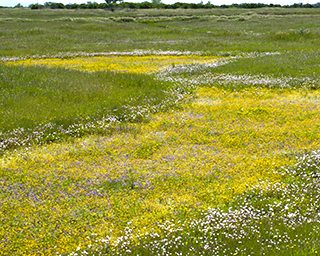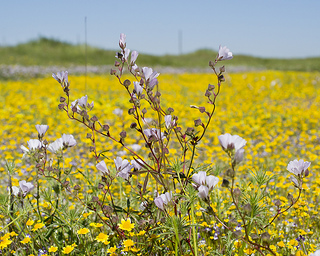Vernal pools are a type of temporary wetland, and are some of the most ecologically important and distinctive areas in California. Vernal pools most typically occur in Mediterranean climates around the world, but the diversity of native flora and fauna found in California’s vernal pools make them especially unique. Vernal pools are depressions in areas where a hard underground layer prevents rainwater from draining downward into the subsoils. When rain fills the pools in the winter and spring, the water collects and remains in the depressions. In the springtime the water gradually evaporates away, until the pools become completely dry in the summer and fall.
 Vernal pool at Mather Field. CDFW photo by Jeb Bjerke.
Vernal pool at Mather Field. CDFW photo by Jeb Bjerke.
 Sidalcea calycosa at the edge of a vernal pool. CDFW photo by Jeb Bjerke.
Sidalcea calycosa at the edge of a vernal pool. CDFW photo by Jeb Bjerke.
Vernal pools support plants and animals that are specifically adapted to living with very wet winter and spring conditions followed by very dry summer and fall conditions. The pools are most beautiful in the spring, when many specially-adapted flowering plants are in full bloom following initial evaporation of surface water. Almost all plants that occur in vernal pools are annuals, meaning they germinate, flower, set seed, and die all within one year. Many vernal pool plant species have seeds that can remain dormant for many years, an adaptation that allows them to survive through periods of drought. Many specially-adapted crustaceans, amphibians, and insects also occur only in vernal pools. Life supported by these unique ecosystems provides important food resources for many species of waterfowl and other birds, and vernal pools are important parts of the connective wetland habitat along the Pacific Flyway.
It is difficult to know how much of California was covered by vernal pool systems prior to the arrival of Spanish explorers, but we do know that most of the historical vernal pool habitat has been destroyed. A vast and rapid loss of vernal pool habitat was first a result of agricultural expansion within the Central Valley followed, to a lesser extent, by urban development. Estimates suggest that close to 90 percent or more of the vernal pool habitat in the Central Valley and in other parts of the state has been lost. Recent studies have documented continuing vernal pool habitat loss in recent decades, with over 13 percent of the remaining Central Valley vernal pool habitat (137,100 acres) being lost from baseline conditions in 1976-1995 to the conditions in 2005. Agriculture and development have also altered the hydrology of land surrounding vernal pools, increasing erosion and runoff and contributing harmful pesticides and fertilizers.
Vernal pools are a type of wetland, and they are protected by state and federal laws. The vernal pools that remain in California support endemic rare plant and animal species, including many that are designated by federal and state government as rare, threatened, or endangered. In 2005 the U.S. Fish and Wildlife Service finalized its Recovery Plan for Vernal Pool Ecosystems of California and Southern Oregon (PDF) that addresses 33 plant and animal species of interest that are endemic to vernal pools, including 15 plants that are listed as threatened or endangered under the California Endangered Species Act.
The Recovery Plan outlines the following Key Elements of vernal pool ecosystem conservation:
- Habitat Protection
- Adaptive habitat management, restoration, and monitoring
- Status surveys for species of interest
- Research
- Participation and outreach
Following these Key Elements and the more detailed steps outlined in the Recovery Plan is important in ensuring that California’s vernal pool habitats do not continue to be lost to agriculture, development and other activities. Protecting vernal pool habitats will mean protecting many endemic plant and animal species, as well as ensuring the continuation of an important connective part of California’s wetland ecosystems.
CDFW has contributed to vernal pool studies through support from the federal Cooperative Endangered Species Conservation Fund also known as “Section 6”, California Endangered Species Tax Check-off Funds and through other mechanisms.
Related Information
For more information on Vernal Pools and California endangered plant species see:
Updated 4/4/2022